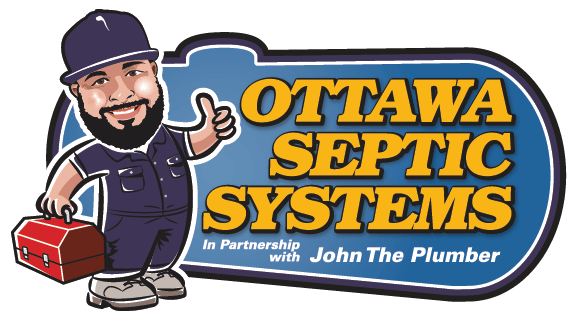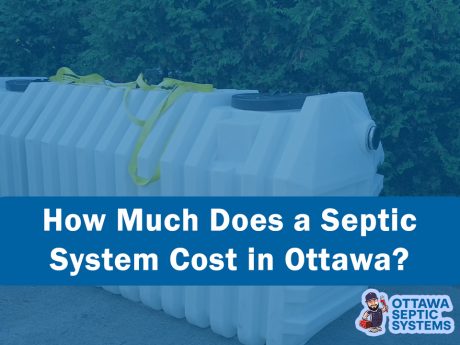If your home isn’t connected to municipal sewers, a septic system manages wastewater on-site using a septic tank and a drain field (leach field). In Ottawa, these systems must meet the Ontario Building Code (OBC) and local regulations to protect underground water.
So, how much does it cost to install a septic system in Ottawa? Most homeowners spend $15,000–$25,000 for a conventional system. In contrast, advanced or tertiary treatment systems typically range from $25,000 to $50,000 or more, depending on the soil type, site conditions, and the size of the home.
Average Septic System Cost in Ottawa
The system cost for a new septic system in the Ottawa area can vary depending on several factors, but typical estimated costs for residential installations are:
- Conventional septic system (gravity design): commonly $15,000–$25,000+
- Advanced treatment system / tertiary treatment system (for challenging soils, small lots, or high groundwater): often $25,000–$50,000+
- Complex sites (steep slopes, limited access, long runs, imported fill, pumps): budgets can exceed $60,000 in some cases
Why the spread? Soil type, site conditions, the type of septic system, and material choices all vary based on the property and OBC requirements, which in turn affect excavation, pipe length, total trench length, and components needed.
For professional septic system installation, contact us today at 613-366-4768 or book online.
Factors That Influence Septic System Cost in Ottawa
Soil and Hydrogeology
- Soil type/soil conditions: The type of soil under your property is one of the biggest cost drivers.
- Sandy soils let water drain quickly, making systems easier and cheaper to build.
- Clay soils and silty mixes drain much more slowly. This often means a longer trench length, a larger leach field, or even a raised bed or advanced treatment system, which adds to the cost.
- Soil test/soil analysis/percolation test: A licensed professional conducts a test to determine how quickly water moves through the soil. This is called T time (the time it takes for water to drop one centimetre in a test hole).
- Lower T time (fast drainage) = smaller bed area → lower cost.
- Higher T time (slow drainage) = bigger bed area → higher cost.
- Groundwater level: If the water table on your property is high, your system may need to be built up as a raised bed or use a tertiary treatment system. Both options protect underground water but increase installation costs.
Site Conditions & Access
Topography: If your property has steep slopes, swales, or uneven grades, excavation takes longer and may need extra erosion controls. This drives up cost.
Access and staging: Limited access, such as narrow driveways, mature trees, or retaining walls, makes it more challenging for trucks and excavators to reach the site. More trucking time and machine hours = higher cost.
Overall landscape: Obstacles such as trees, fencing, or rock outcrops often necessitate additional clearing and site restoration, which increases the cost.
Home Size & Occupancy (Flow)
The Ontario Building Code (OBC) sizes septic systems based on how many people your home could reasonably hold, not just how many live there now.
- Bedroom count: The OBC assumes two people per bedroom. A three-bedroom house generates less daily flow than a five-bedroom house, so larger homes require bigger tanks and leach fields.
- Fixtures: High-flow features, such as soaker tubs, multiple showers, or extra bathrooms, increase your home’s daily water flow rate. This usually means upsizing the septic tank and drain field.
- Future changes: If you plan to add a secondary suite or basement apartment, your system must be designed to accommodate the extra flow now, even if it hasn’t been built yet.
Type of Septic System
Conventional system (gravity): Uses natural gravity to move wastewater. This is the least complex and least expensive option, but it only works where site conditions allow.
Advanced/tertiary treatment system: Required on tougher sites (slow soils, high groundwater, or small lots). These systems pre-treat effluent to a higher standard before it enters the drain field. They’re more effective but also more costly.
Materials & Logistics
- Tank choice: Most Ottawa homes use concrete tanks because they are durable and cost-effective. Poly and fibreglass tanks are options, but they may change the price.
- Stone and septic sand: Availability and quality of clear stone and septic sand directly affect your cost.
- Trucking and delivery: If your property is far from suppliers or hard to access, trucking time for materials becomes a significant cost line.
Design, Permits & Inspections
Septic system design: An OBC-qualified designer must prepare drawings, size the system (using daily flow, T time, and trench length), and submit calculations.
Permits: You’ll need approval from your local municipality before construction begins. Some sites also require extra permissions from conservation authorities.
Field inspections: Inspectors will visit at key stages (tank installation, trench completion, final grading) to ensure the system meets all OBC and local regulations.
Bottom line for Ottawa homeowners: Soil, site conditions, home size, and system type all combine to determine your septic system cost. A simple sandy-soil property with good access may stay near the lower end of the cost range, while a clay-heavy lot with high groundwater can easily double that budget.
Sizing 101: How the OBC Affects Septic Tank and Field Costs
Daily Flow & Bedroom Assumptions
The OBC uses your bedroom count to estimate how much water your household could use each day (called the daily flow rate). The assumption is straightforward: more bedrooms mean more people, which in turn means more wastewater.
- A 3-bedroom home usually requires a 3,600–4,000 L septic tank.
- A 4-bedroom home typically needs a 4,000+ L tank.
- A 5-bedroom home may require a 5,000 L+ tank.
A good rule of thumb is that the tank size should be about twice your daily flow number. Extra bathrooms, soaker tubs, or a future secondary suite can all increase the required size.
From Soil Drainage Rate (T Time) to Trench Length
The soil percolation test measures how quickly water drains through the ground. This is called T time (how many minutes it takes for water to drop 1 cm in a test hole).
Designers combine your daily flow rate with your T time to calculate the total trench length of your drain field:
- Sandy soil (fast drainage): Shorter trench lengths, smaller field → lower cost.
- Clay soil (slow drainage): Longer trenches, bigger field, or even a raised bed or advanced treatment system → higher cost.
Why This Matters for Homeowners
Sizing rules explain why your septic system might cost more (or less) than your neighbour’s. A smaller 3-bedroom home on sandy soil could stay within the $15,000–$20,000 range, while a larger 5-bedroom home on clay soils could easily exceed $30,000–$50,000.
Ottawa Cost Ranges by System Type
Conventional Septic System (Gravity)
- Typical install: $15,000–$25,000+
- Best for: sandy soils, level grades, good access, and lots large enough for code-compliant separation distances.
- Notes: Lowest complexity and usually the quickest installation when conditions are favourable.
Advanced / Aerobic Treatment System
- Typical install: $25,000–$35,000+
- Best for: Sites needing higher effluent quality to shrink the bed footprint or address soil/lot constraints.
- Notes: Uses aeration to accelerate biological treatment; requires power and regular septic maintenance.
Tertiary Treatment System with Raised Bed
- Typical install: $30,000–$50,000+ (and higher on difficult sites)
- Best for: Clay soils/silty sites, high water tables, or where setbacks force engineered beds.
- Notes: May require imported septic sand, pump stations, and extended pipe length, all of which increase total cost.
Component-Level Cost Drivers (What You’re Paying For)
1) Tank & Appurtenances
- Concrete tanks are commonly used in Ottawa due to their durability and cost-effectiveness. Poly and fibreglass exist but may differ in pricing/handling.
- Larger tanks, multi-compartment tanks, and effluent filters affect system cost.
2) Drain Field / Bed Construction
- Clear stone, septic sand, chamber systems, and geotextiles vary by design.
- Total trench length scales with daily flow and T time.
- Longer pipe length and deeper excavation add labour and materials.
3) Pumps & Controls (If Needed)
- Where gravity won’t work, dosing pumps, floats, control panels, and alarms add capital and ongoing maintenance.
4) Excavation & Site Work
- Machine and operator time depend on access, haul distances, overall landscape, and whether rock removal or shoring is required.
- Site restoration (topsoil, sod, hardscape reinstatement) is an additional cost to plan for.
5) Trucking & Materials Logistics
- Trucking time for aggregates, septic sand, and tanks is a real budget line, especially on rural roads, long driveways, or limited delivery windows.
6) Professional Services, Permits & Inspections
- Septic system design (OBC-qualified)
- Applications and permits
- Field review and as-built documentation (as required)
Example: How Site Conditions Change the Budget
- Sandy soils + level site + easy access:
- Likely conventional septic system, shorter trenches, minimal septic pumping→ lower total cost band.
- Clay soils + seasonal high water:
- Often requires a raised bed with imported septic sand, possible pump dosing and treatment → higher total cost band.
- Steep slopes + tight lot lines:
- Additional excavation measures, erosion control, specialized distribution, longer pipe length → elevated costs.
Cost Breakdown Cheat Sheet
Cost Driver | What Affects It | Notes for Ottawa Homeowners |
Design & Permits | Bedrooms, fixtures, local regulations | OBC drawings, permits, and septic inspections are required before installation can begin |
Septic Tank | Home size, daily flow rate, tank material | Concrete tanks are most common; larger homes need larger tanks |
Drain Field | Soil type, T-time, trench size | Sandy soils are easier and cheaper than clay soils, which often need larger or raised beds |
Pumps & Controls | Groundwater level, grade, site conditions | Pumps, alarms, and electrical components may be needed if gravity alone won’t work |
Excavation | Site access, slopes, depth, and soil type | Hard-to-reach or rocky properties increase labour; restoring landscaping adds cost |
Materials & Delivery | Stone, sand, tank hauling and, trucking time | Longer delivery distances mean higher costs for materials |
Restoration | Lawn, trees, driveways, hardscapes | Budget for sod, reseeding, or driveway/landscape repair after installation |
Replacement vs. New Installation
Frequently Asked Questions
How much does a septic system cost in Ottawa?
What is the difference between a conventional system and an advanced/tertiary system?
Do I always need a percolation test?
Can my clay soils support a conventional bed?
How are tanks sized?
What additional costs should I plan for?
Potential additional costs include clearing/trees, hardscape removals, unexpected rock, long trucking time, imported septic sand, pumps/controls, and site restoration (topsoil/sod). Permits and septic inspections are also required.
How long does a septic system last?
With correct design, construction, and septic maintenance, many systems provide decades of service. Lifespan depends on usage patterns, water chemistry, and protecting the leach field from compaction and flooding.
Why Choose Ottawa Septic Systems
- OBC-compliant design & installation tailored to site conditions
- Clear communication around choices, constraints, and cost drivers
- Long-term view: buildability today, serviceability tomorrow
If you’re planning a project, we’ll outline a professional process to evaluate your property, develop a compliant design, and provide a proposal.
For professional septic system installation, contact us today at 613-366-4768 or book online.
Key Takeaways
- Costs vary depending on soil, site, and system type.
- Proper testing (T-time) and OBC-based design prevent expensive missteps.
- Choosing between conventional and tertiary treatment system solutions hinges on soil conditions, lot constraints, and performance targets.
- Up-front design and thoughtful installation protect underground water and your investment.
Need help navigating design, permits, and construction in the Ottawa area? Contact Ottawa Septic Systems to discuss next steps and explore a professional path forward.

